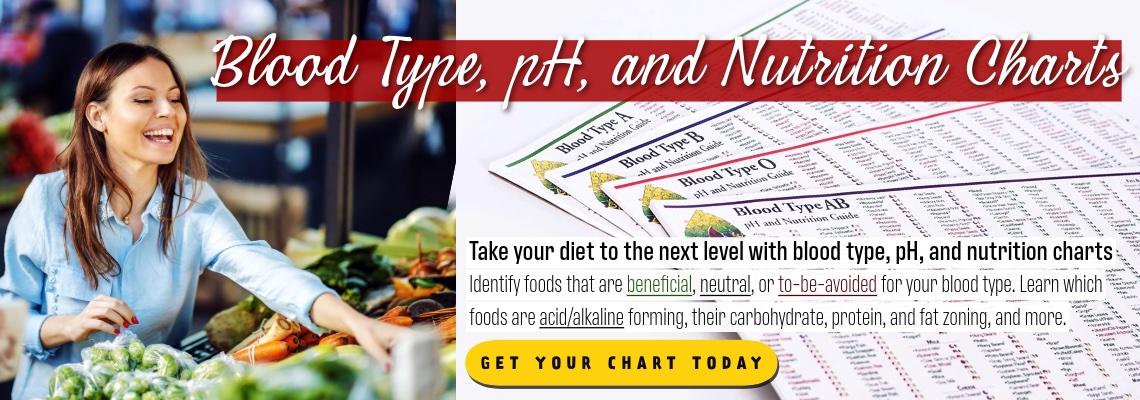
When people are new to natural healing, they can often feel overwhelmed by the various supplements and modalities that are available. Often, they just don't know where to begin—especially when there are so many different companies and healers telling you to “buy our products!”
Although I do sell herbs and nutritional supplements, there are many things that are important to improving health that don't involve swallowing something. In fact, there is one key to helping people improve their health that has solved more health problems than anything else I've ever learned. It has helped me resolve cases where people had been to numerous doctors and healers but had made no progress. It is an underlying problem in all chronic illness. This problem is tension in the solar plexus and/or a hiatal hernia.
My own health improved dramatically when Jack Ritchason taught me about the hiatal hernia (also called a hiatus hernia), and pulled mine down. At the same time, I learned about the ileocecal valve and how to fix that, too. Learning to fix these problems was the single biggest key to improving my health and has been a big key in improving the health of others, too.
Before I learned how to fix this problem, I had to be extremely careful about what I ate and I had to take a lot of herbs and supplements to stay healthy. I also had to do a lot of cleansing. Even then, my health was not as good as I would have liked it to be.
Once my hiatal hernia was fixed and my ileocecal valve was closed, I found that I could eat a wider variety of foods without suffering a negative impact to my health. I also had to take less than half as many herbs and supplements to get the same results. When this was corrected, I had more energy, gained muscle mass and felt better overall.
Jack taught me that all chronically ill people have a hiatal hernia. I'm not sure that this is the case, but I do know that nearly all chronically ill people have tension at the solar plexus that is interfering with digestion and breathing. Whether this condition would be considered a full-blown hiatal hernia by the medical profession or not, I don't know.
What is a Hiatal Hernia?
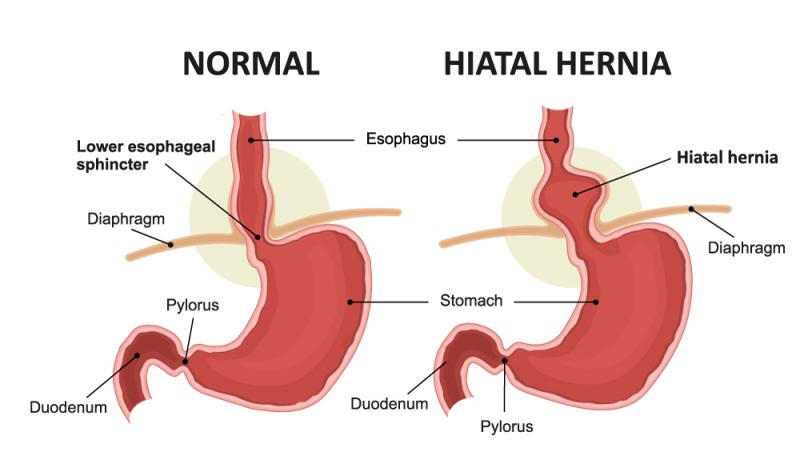 The esophagus passes through an opening in the diaphragm muscle called the hiatus. The esophagus ends where it connects to the stomach. The stomach lies in the abdominal cavity below the diaphragm. What a person has a hiatal hernia, a portion of the stomach protrudes up into the chest cavity through the opening for the esophagus (as pictured below).
The esophagus passes through an opening in the diaphragm muscle called the hiatus. The esophagus ends where it connects to the stomach. The stomach lies in the abdominal cavity below the diaphragm. What a person has a hiatal hernia, a portion of the stomach protrudes up into the chest cavity through the opening for the esophagus (as pictured below).
The diaphragm muscle is supposed to contract downward into the abdominal cavity to expand the chest area when we inhale. As the diaphragm relaxes upward, we exhale. This is why a baby's tummy rises and falls when they are breathing. The movement of the diaphragm causes the abdomen to expand outward when we inhale and relax inward as we exhale.
When the stomach is in the way of the diaphragm, it can't move like it is supposed to, so the person can't take a deep abdominal breath. In order for the person with a hiatal hernia to take a deep breath, they must lift their chest and shoulders.
This is what I do to determine if a person has a hiatal hernia. First, I ask them to take a deep breath. If they breathe upwards into their chest, I show them how to breathe abdominally and ask them to try it. A person who has a hiatal hernia cannot take an abdominal breath—even when I try to coach them how to do it.
Chronically ill people are almost universally chest breathers. Occasionally, with a little coaching they can take a little bit of an abdominal breath, but even then it is strained, suggesting that they may have a partial hiatal hernia. Some chest breathers seem able to be taught how to breathe abdominally and can do it with coaching. This suggests they don't have a hiatal hernia, but they still have tension in the solar plexus, which is inhibiting breathing. I believe this tension is adversely affecting digestion, too, even though the problem is not actually a hiatal hernia.
 Check yourself, right now. Place one hand on your abdomen and one hand on your chest. Take a deep breath. Your chest should move only slightly, but your abdomen should expand outward noticeably when you inhale. If your chest expands outward and your stomach pulls inward when you take a deep breath, you probably have a hiatal hernia or at least tension in the solar plexus.
Check yourself, right now. Place one hand on your abdomen and one hand on your chest. Take a deep breath. Your chest should move only slightly, but your abdomen should expand outward noticeably when you inhale. If your chest expands outward and your stomach pulls inward when you take a deep breath, you probably have a hiatal hernia or at least tension in the solar plexus.
Medical literature suggests that 1-20% of the population have a hiatal hernia, but about 95% of the people I see have problems breathing deeply from their diaphragm. While this doesn't mean they have a medically-diagnosable hiatal hernia, it does suggest they have problems with both breathing and digestion that are contributing to their health problems.
Problems Caused by a Hiatal Hernia
The first problem a hiatal hernia creates is shallow breathing. Shallow breathing increases acidity in the body because breathing is the first line of pH buffering. Shallow breathing also increases pain, since pain is usually a sign of lack of oxygen to the tissues. Shallow breathing reduces energy levels, because the cells need oxygen to create energy. A low oxygen environment is ideal for the growth of bacteria, parasites and cancer cells. In short, lack of oxygen is one of the primary causes of chronic illness—a cause that is overlooked by most people who are selling nutritional supplements or teaching people about nutrition or health.
That's bad enough, but the problem doesn't stop there. Besides causing shallow breathing, the hiatal hernia also inhibits digestion. It causes stress on the nerves to the stomach, which reduces secretion of acid and enzymes. As a result, proteins are not properly digested and minerals are not properly absorbed. This is why people with severe hiatal hernias lack muscle tone and are often very sickly. Many young people with this problem are excessively thin, while older people tend to be overweight with poor muscle tone.
Depending on how far up into the diaphragm a person's stomach protrudes, a hiatal hernia may or may not cause problems with acid reflux. If the stomach is in certain positions, the sphincter at the top of the stomach will not close properly to hold acid in the stomach. In my experience, people with chronic acid reflux always have a hiatal hernia. However, the reverse is not true—not everyone with a hiatal hernia experiences acid reflux.
The ironic thing is that people with hiatal hernias don't produce enough hydrochloric acid to properly digest food, but because they are prone to acid indigestion, heartburn and acid reflux, they are frequently neutralizing what little acid they do produce with antacids and acid blockers. The result is a vicious downward spiral of declining digestive function and general health.
The Ileocecal Valve
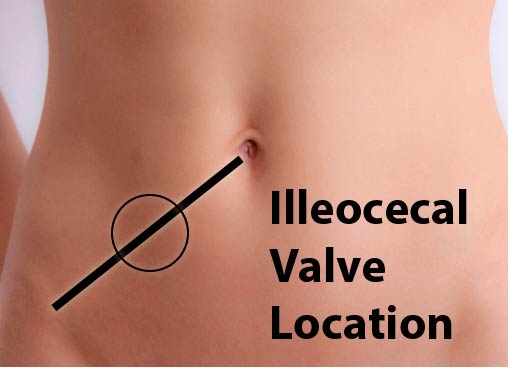 The problems we've discussed so far are directly caused by the hiatal hernia, but there are also numerous secondary problems caused by this condition. For instance, a hiatal hernia will often cause frequent gas and bloating. This is because improperly digested protein will accumulate in the intestinal tract and contribute to intestinal irritation and inflammation. Poorly digested food irritates the ileocecal valve (which separates the small intestine from the colon) causing it to become inflamed. When the ileocecal value is inflamed, it swells and the swelling prevents it from shutting properly. This allows bacteria from the colon migrate into the small intestines and feast on the sugars in the small intestine. This will cause severe gas and bloating. I've relieved many severe cases of bloating just by closing the ileocecal valve.
The problems we've discussed so far are directly caused by the hiatal hernia, but there are also numerous secondary problems caused by this condition. For instance, a hiatal hernia will often cause frequent gas and bloating. This is because improperly digested protein will accumulate in the intestinal tract and contribute to intestinal irritation and inflammation. Poorly digested food irritates the ileocecal valve (which separates the small intestine from the colon) causing it to become inflamed. When the ileocecal value is inflamed, it swells and the swelling prevents it from shutting properly. This allows bacteria from the colon migrate into the small intestines and feast on the sugars in the small intestine. This will cause severe gas and bloating. I've relieved many severe cases of bloating just by closing the ileocecal valve.
An open ileocecal valve is like having your septic tank or the sewer back up into your kitchen. Not a very pleasant thought is it? About 95% of all people with a hiatal hernia also have an open ileocecal valve, although occasionally you'll find one without the other. An open ileocecal valve weakens the entire body.
You can locate the ileocecal valve by drawing an imaginary line from your belly button to the protrusion of bone on the front of your right hip. The ileocecal valve is located just under the halfway point along this line. Find this point right now and press inward. If you feel pain when you press on this spot, you probably have an open ileocecal valve. You can close it by massaging this area using small circular movements while breathing deeply. When the pain goes away, the valve is closed. You'll probably need to do this at least once a day for a few weeks to keep it closed.
Other Problems Related to a Hiatal Hernia
If the hiatal hernia protrudes upward far enough, it puts pressure on the bottom of the heart. Occasionally, I have seen people with a rapid or irregular heartbeat which cleared up when their hiatal hernia was fixed. Also, Jack Ritchason taught me that a large percentage of heart attacks (about 50%) are triggered by intestinal gas and bloating putting pressure on the heart via a hiatal hernia. So, add cardiac problems to the list of potential problems from a hiatal hernia.
Since the esophagus has to be shortened because the stomach is protruding upward, this can cause a slight “kink” in the esophagus. This often happens in the throat area, which can cause the sensation of a “lump” in the throat. It can also cause difficulty in swallowing food or capsules. If this “kink” in the esophagus occurs near the thyroid, it can irritate the thyroid. In younger people, this can cause the rapid metabolism that makes them very thin. In older people, it can cause low thyroid and excess weight.
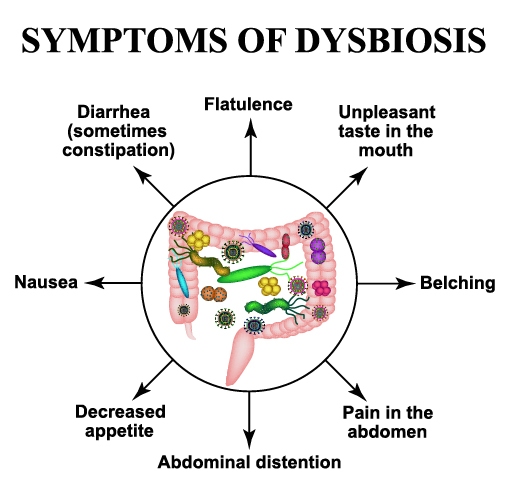 The shallow breathing and lack of hydrochloric acid (HCl) production can cause an over acid pH in the body, which makes a person more susceptible to infection. Lack of HCl also makes one more prone to infection because HCl kills infectious organisms in the stomach so they can't reach the small intestines. Lack of HCl also makes one more prone to fungal infections. A person with low stomach acid typically develops intestinal dysbiosis, the symptoms of which are shown to the right.
The shallow breathing and lack of hydrochloric acid (HCl) production can cause an over acid pH in the body, which makes a person more susceptible to infection. Lack of HCl also makes one more prone to infection because HCl kills infectious organisms in the stomach so they can't reach the small intestines. Lack of HCl also makes one more prone to fungal infections. A person with low stomach acid typically develops intestinal dysbiosis, the symptoms of which are shown to the right.
Improper digestion of proteins and lack of proper mineral absorption have more subtle and far-reaching effects. For starters, a hiatal hernia weakens the immune system and makes one more prone to infectious diseases, autoimmune conditions and cancer. It also weakens the structural system, causing more problems with arthritis, back pain, osteoporosis and other structural problems. Improperly digested proteins also contribute to chronic respiratory problems such as chronic sinus congestion, allergies and asthma. The glandular system is also weakened.
In muscle testing some clients, I've found that nearly every system of the body tested weak. Just by working on the hiatal hernia, I've had most of these systems test strong again. Clearly, the hiatal hernia weakens the whole body, so I think instead of saying, “death begins in the colon,” we should say, “death begins in the stomach.”
Correcting a Hiatal Hernia
A hiatal hernia is a mechanical problem. You can't fix it just by taking nutritional supplements. You have to mechanically manipulate the stomach downward from the diaphragm. The handout on the facing page offers several suggestions on how this can be done. All of the listed techniques actually work. Feel free to duplicate and share this handout.
In addition to the techniques listed in the handout, let me offer a few additional ideas. First, I have found dandelion flower essence to be very helpful in relaxing the muscle tension at the solar plexus that accompanies a hiatal hernia. There is often a noticeable relaxing of the area and a deepened breathing after just one dose.
Massaging the abdomen will also help this problem. Concentrate on massaging downward from below the rib cage. This can be done from a standing position or while lying down.
Practicing deep breathing will also help fix a hiatal hernia. I often have to coach clients on how to breathe. Concentrate on pushing your belly out as you breathe in. As you exhale, suck in your belly and pull your diaphragm upward. Exhale as deeply as you can. This helps release the diaphragm and make the next breath fuller and deeper. It may even help release the hiatal hernia. Exhaling fully may also help the stomach to slide back down into place. Since practicing exhaling more deeply my lung capacity has greatly increased. This is another trick I learned from DeAnna Hansen (developer of the Love Your Body Beautiful self-massage techniques).
Dealing with Causes
The question naturally arises, what causes a hiatal hernia? The problem is typically attributed to physical issues, such as excess weight, pregnancy, lifting heavy objects, constipation, and frequent coughing. I've observed that a large percentage of women in their 8-9th month of pregnancy develop this problem. Many obese people also have this problem. However, those who seem to have it the worst are usually very thin, not pregnant or overweight, which suggests other causes.
Jack Ritchason and other natural healers often attribute the problem to intestinal gas and bloating putting pressure on the stomach, but I think that this gas and bloating are not the primary causes of the problem. They may aggravate it, but they aren't the cause.
Stress, however, is a big factor. I read once that people with hiatal hernias often have a hard time expressing anger. They “swallow” it instead of expressing it or finding constructive ways of dealing with it. I believe this is getting closer to the real cause of a hiatal hernia since I have found that doing anger release work will often relax the stomach immediately.
The Hiatal Hernia and Gut Instincts
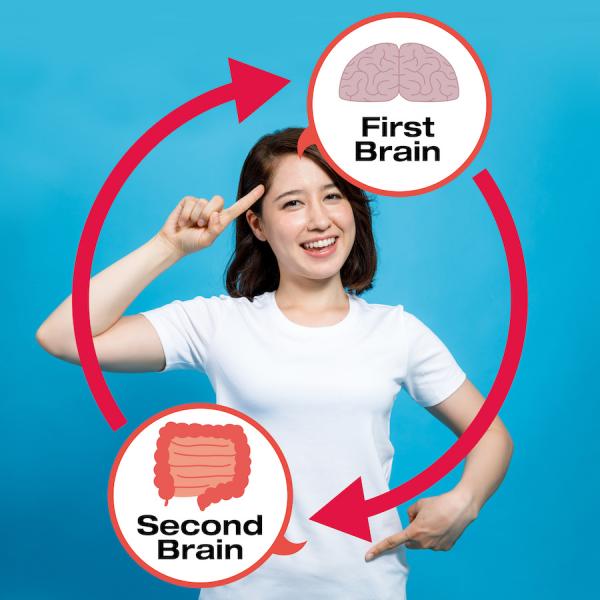 For a long time, I accepted the idea that the hiatal hernia was linked with suppressed anger, but I discovered that there is a deeper problem at work—not paying attention to one's guts. In other words, not listening to one's instincts.
For a long time, I accepted the idea that the hiatal hernia was linked with suppressed anger, but I discovered that there is a deeper problem at work—not paying attention to one's guts. In other words, not listening to one's instincts.
You've probably heard the phrase “gut instinct.” Well, we all have gut instincts because we have a “gut-brain.” The nervous system and the digestive system develop from the same embryonic tissue and the guts produce neurotransmitters just like the brain. There are also more nerves sending messages from the intestines to the brain than there are nerves sending messages from the brain to the intestines.
Most people in modern Western society don't pay much attention to the messages their guts are sending. But, guts can and do “speak” to us, and we can learn to listen by paying attention to the solar plexus.
The solar plexus is the soft area just underneath the breastbone and above the stomach. This area marks the place where a network of nerves radiating outward in all directions like the rays of the sun, hence, the term solar plexus. At the Las Vegas exhibition Bodies (which displays actually bodies and organs preserved through a special plastic) I got a chance to see the solar plexus nerves and it really is a fascinating nervous structure.
In muscle testing, a muscle weakens when something is “wrong” and tests strong when things are “good” or “right.” The solar plexus is an internal system of muscle testing that is constantly responding to the same subtle influences one picks up with muscle testing. The solar plexus tenses when something is wrong and relaxes when something is all right. The tension makes us hold our breath and the relaxation helps us breathe deeply.
Native people learned to depend on this “knot” in the stomach to warn them of danger and guide them to safety. Soldiers in war often report that learning to pay attention to this has saved their lives by warning them of danger.
You can observe the solar plexus response at work by doing an experiment with essential oils. Get a variety of essential oils and find a “test” subject. Have the person stand up straight and close their eyes. Then, pass an open bottle of some essential oil under their nose so they can smell it.
If the oil has a positive effect, you'll see them relax a bit, breathe more deeply and lean forward slightly. If the oil has a negative effect on them, you'll see them tense a bit, breathe more shallowly and lean slightly backward. This observable reaction will center on the response of the solar plexus to the oil. Try several different oils to observe different reactions.
Body versus Brain
Most people in Western society live primarily in their heads. In fact, nearly all of us have received the message since childhood that the body and its feelings or emotions are not to be trusted. As a result of this training, we learn to live in our heads, believing the things we have been taught and ignoring the messages we receive from our body and our emotions.
In fact, Western society places the mind as pre-eminent and the body and heart as secondary. Descartes said, “I think, therefore I am,” and Western civilization has considered thinking to be the seat of being ever since. Traditional Christianity generally considers the body to be evil and the soul (or mind) to be pure. This is true even in “new age” circles, where people are taught that we are “mind” and the body is an illusion.
Even in the human potential movement, the body and its feelings are given a “second place” rating. Those who talk about the “Law of Attraction” (as discussed in the DVD, The Secret and the movie What the Bleep?) typically say that thoughts create feelings and feelings create actions. In other words, feelings and the physical body are just effects—the mind is the cause. Even in modern science, which teaches that mind or soul are just chemical processes in the physical body, the idea that the body and its feelings have something to tell us is scoffed at.
Wherever we look there appears to be a universal bias against the body and emotions. Culturally, then, we live in our heads and trust “book knowledge” over subjective experience. No wonder we don't listen to our “guts.”
I'd like to make the case that body, mind, and spirit are equally important, completely interactive, and that the mind is not the only source of “knowing.” Yes, we can learn and do things through our mind, but the guts (which represent the body) and the heart (which represents the spirit or soul), know things the head does not.
There is emerging scientific evidence for this viewpoint. Research is showing that we have a “gut-brain” and that every part of our body “thinks” or has intelligence. However, rather than talking about the science, let me give you a practical example from my own life about the value of listening to one's guts.
A Personal Experience with Listening to My Guts
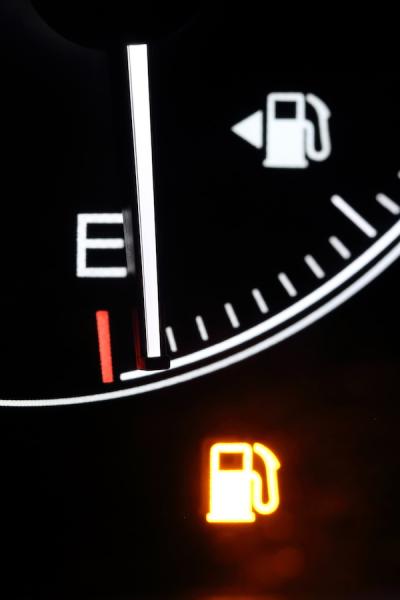 About a year or two after I first learned about the solar plexus response I was driving back to Roosevelt from Salt Lake City here in Utah. It was late at night and I was traveling in a friend's car. Right after leaving Heber City, my solar plexus knotted up. I knew this meant that something was wrong, but I didn't know what.
About a year or two after I first learned about the solar plexus response I was driving back to Roosevelt from Salt Lake City here in Utah. It was late at night and I was traveling in a friend's car. Right after leaving Heber City, my solar plexus knotted up. I knew this meant that something was wrong, but I didn't know what.
I started asking questions mentally, “Is it this? Is it that?” The knot in my stomach just kept getting tighter and tighter, and I was getting more and more concerned. What was wrong? After about five minutes of trying to figure it out, I suddenly saw the ‘real' gas gauge. What I thought was the gas gauge was actually the temperature gauge. The gas gauge was on empty.
As soon as I realized I was nearly out of gas, the knot in my stomach relaxed and I breathed a “sigh” of relief. (That's how your solar plexus lets you know you've got it right.) I turned the car around and went back to Heber City to fill up the tank.
It's about 80 miles from Heber City to Roosevelt, and there is only one gas station on that entire stretch of road—and it isn't open at night. I would have run out of gas on a lonely stretch of road in the middle of nowhere late at night if my solar plexus hadn't alerted me to the fact that something was wrong.
Since that experience, I've learned to “pay attention” to my solar plexus more and it has helped me out in many situations. I believe the solar plexus is the body's way of “talking” to you. As with muscle testing, the body is sensing the vibrations of influences around you and picking up information through the various senses. When the body senses vibrations or inputs that are dangerous, it responds through the solar nerve plexus and we “feel” something in our abdomen.
Besides listening to the solar plexus, where the body talks to us, I also believe that we should listen to the heart, where our emotions talk to us. The heart also produces hormones and neurotransmitters and thus, “thinks.” My heart has told me things many times that my head couldn't understand, but things have always turned out better when I've listened to my heart and not allowed my head to override it.
Both the heart and the body are able to sense things that the physical brain doesn't know how to process into words. Words are secondary to experience, simply being a representation of experience. We should trust experience over words and the subjective experience of our own heart and gut instincts over the word-based knowledge that we were programmed with since childhood.
Gut Knowing and the Hiatal Hernia
It's time to wrap this all up and explain what I believe to be the underlying cause of the hiatal hernia and why it appears to be universally present in chronic illness. Let's just suppose for a moment that I am correct when I say that the solar plexus response is our internal “muscle testing” sensor that is designed to tell us what is good for us and what we should avoid.
Every time we go to do something that is harmful to our body (and thus to our health) the solar plexus is going to tense up. This pulls the stomach upward and tenses it against the diaphragm. If we were listening, we would look around and try to figure out where the harmful influence was. As soon as we identified the source of harm or danger, the solar plexus would relax again.
However, we don't listen. We just ignore the message. Thus, day after day we are doing things that cause our solar plexus to tense up. Over time, this builds into a chronic tension that interferes with breathing and digestion. At the least, we develop chronic tension in the solar plexus. At worst, we develop a hiatal hernia and its attending problems. The constant harm we do to the body also leads to chronic illness.
If we were paying attention to what the body is trying to tell us, we would be able to avoid most harmful influences. However, we have been taught to override the wisdom of the body and replace it with the “learning” of the brain. Few people, even in the natural health movement, actually try to listen to their body. It's all about “head” knowledge.
It takes courage to follow your instincts. It takes real courage to choose to not do something that everyone else says is “perfectly safe” when your instinct tells you it's not. It takes courage to not fall in with the group—family, friends, religion, societyÄÂand make choices that are different because of what your instincts and heart are telling you. This is especially true when you can't logically justify why you are making those choices when it's just a “feeling” you have.
That's why they call it “guts.” Courage takes “guts.” Do you have the “guts” to listen to the wisdom of your body and heart? Do you have the courage to make a choice that you can't logically justify because something simply “feels” right or wrong? That's really having guts. I encourage you to stop ignoring the tension in your solar plexus and start doing the things that allow it to relax. I guarantee that both your digestion and your health will improve.
Self-Help Corrections for a Hiatal Hernia
Start by checking your breathing. Accessing your pattern of breathing is the first step in correcting a hiatal hernia. Put your hand on your abdomen as you breathe. If your abdomen moves in and out more than your chest, you are probably handling your stress well, or at least, you aren't letting stress control you. You probably don't have a hiatal hernia, either.
If you are breathing from the top of your lungs, just sit back and relax to allow your breathing apparatus to revert to normal abdominal breathing. If it doesn't, then you need to relax the diaphragm and help your stomach move downward. To do this, take lobelia essence or blue vervain in liquid form. Then, practice breathing from the abdomen again. You can also practice abdominal breathing while relaxing in a bath with lavender oil. It is also helpful to massage your abdomen, especially in the area under the rib cage while concentrating on breathing deeply.
When you are practicing breathing deeply, practice exhaling completely. Force as much air out of your lungs as you possibly can before inhaling again. This both exercises and relaxes the diaphragm and will help bring down the stomach.
 Find healthy ways to vent your repressed anger and frustration. This releases tension from the diaphragm and will help defuse much of the tension maintaining the hiatal hernia problem. For example, try taking a long, slow deep breath and feel the tension build up in your diaphragm (like you are starting to get angry). Make your hands into fists and raise them up in front of you as if you want to punch somebody. Exhale forcefully with an angry “huh!” sound while shaking your fists downward like you are hitting something. Do this several times, safely discharging your inner tension and frustrations.
Find healthy ways to vent your repressed anger and frustration. This releases tension from the diaphragm and will help defuse much of the tension maintaining the hiatal hernia problem. For example, try taking a long, slow deep breath and feel the tension build up in your diaphragm (like you are starting to get angry). Make your hands into fists and raise them up in front of you as if you want to punch somebody. Exhale forcefully with an angry “huh!” sound while shaking your fists downward like you are hitting something. Do this several times, safely discharging your inner tension and frustrations.
You can also throw a mini-temper tantrum. Again breathe in deeply, clench your fists like you are angry, and then as you exhale, yell, scream or just use a sound like "arrr" while shaking your fists and stomping your feet like a little child throwing a tantrum. This may sound really stupid and may be very hard for you to do, but I've seen the stomach come down and the diaphragm noticeably relax after someone has done this.
Other methods of dealing with stress include changing your environment, finding new ways to resolve problems, and communicating your thoughts and feelings honestly with others.
It is also possible to bring down a hiatal hernia using manual manipulation. Find a chiropractor a massage therapist who knows how to manually manipulate a hiatal hernia. You can also massage your own abdomen daily for about 5-15 minutes paying special attention to massaging the area under your ribs.
As an alternative, the following technique can be used as a self-help form of manual manipulation.
Drink a pint of warm water first thing in the morning. Next, stand on your toes and drop suddenly to your heels several times. The force of this little jump and the weight of the water help pull the stomach down in place while the warm temperature of the water relaxes the stomach area. Taking a dropper full of lobelia essence with the water will relax the stomach and make the treatment more effective.
If you're adventurous, jump off a chair or down a short flight of stairs to get the same effect. The idea behind this technique is to get your stomach to “drop” as if you were in an elevator that suddenly started going down.
 If this doesn't solve the problem, place both hands under your breastbone in the center of your rib cage. Take a deep breath and press your fingers firmly into the solar plexus area (just under the breastbone). As you forcefully exhale, push your fingers downward and bend forward slightly. Be careful not to push your fingers up under the rib cage. Repeat this action several times. Do this before meals on an empty stomach.
If this doesn't solve the problem, place both hands under your breastbone in the center of your rib cage. Take a deep breath and press your fingers firmly into the solar plexus area (just under the breastbone). As you forcefully exhale, push your fingers downward and bend forward slightly. Be careful not to push your fingers up under the rib cage. Repeat this action several times. Do this before meals on an empty stomach.
It is usually important to work on the ileocecal value when correcting the hiatal hernia. This valve is located on the right side of the abdomen midway between the belly button and the right hip bone. Just start massaging in that area and if there is any pain or discomfort in that region gently massage the area while breathing deeply until the pain goes away. Do this at least once a day.
Finally, although nutritional supplements won't correct a hiatal hernia, they will help it heal as you mechanically get the stomach to move downward. Supplements can also help the ileocecal value, which will help the hiatal hernia to heal, too. The companies that make these supplements are listed in parenthesis after the supplement(s).
Red raspberry is a very good herb for toning abdominal muscles and is useful to take in capsules or teas when correcting a hiatal hernia. Trace mineral supplements such as Colloidal Minerals, Mineral Chi Tonic or HSN-W (NSP) will also be helpful in promoting healing from a hiatal hernia. To correct the ileocecal value problem and improve the hiatal hernia problem at the same time I have found two formulas to be helpful. One is Intestinal Soothe and Build and the other is Spleen Activator. Slippery elm is also useful here.
People who suffer from a hiatal hernia also benefit from taking digestive enzymes. My favorites are Proactazyme (NSP), Digestazon Plus (Amazon) and Absorb-Aid (a health food store brand).
To treat hiatal hernia syndrome that is accompanied by heartburn, use slippery elm powder mixed with a little juice or water or whole leaf aloe vera juice. If you continue to get acid in your throat, sleep with your head and chest slightly elevated. Elevate your pillow to raise your head and chest.
I find flower essence to be very helpful in correcting the underlying emotional issues that contribute to a hiatal hernia. Dandelion flower essence in particular is very helpful, which is interesting to me as Jack Ritchason taught me that dandelion was a very good herb for people with a hiatal hernia. Dandelion flower essence is for people who are two "uptight." They over form and over plan their lives and don't know how to relax and "go with the flow." I've seen dandelion flower essence alone noticeably relax the diaphragm after just one dose.
Chamomile and St. John's wort are two other herbs that regulate the solar plexus and both can be helpful as flower essences for correcting a hiatal hernia. Chamomile is helpful for promoting a more relaxed, even and "sunny" disposition while St. John's wort helps people get in touch with their "gut instincts." Both are helpful as herbs, too.
Finally, I might mention that people with the thyroid-type body build (tall and thin) usually have the most problems with a hiatal hernia. They also tend to have adrenal weakness and the two problems (adrenal weakness and a hiatal hernia) seem to go hand in hand. Building the adrenals helps one manage stress better, so I also recommend that people with a hiatal hernia work on building up their adrenal glands, too. Adrenal Support and Nervous Fatigue Formula (NSP) are the two supplements I use most often for this purpose. However, licorice root and adaptagenic herbs like Eleuthero root are also helpful.
I have also posted video demonstrations on how to work on a hiatal hernia on yourself and others. Be sure to watch these videos. Since writing this article, I have also learned that SIBO (small intestinal bacterial overgrowth) is also a factor in this problem. So I recommend reading that article, too.
Video Demonstrations
Here are some video demonstrations I did about how to identify and correct a hiatal hernia. These videos are hosted on our YouTube channel.
Here is the first video clip:
Here is the second video clip:
Steven's Articles
-

-
The Evidence for Berberine
A yellow alkaloid found in traditional infection-fighting…
-

-
The Sensible Use of Caffeinated Herbs
Kola nuts, guarana, and yerba mate and other herbs…
-

-
The Health Benefits and Problems with Coffee
This popular caffeinated beverage can be beneficial…
October
-

-
Understanding Caffeine & Cellular Adaptation
Preserving the power of caffeine's buzz and the…
September
-

-
Horseradish
A pungent spice for aiding protein metabolism…
-

-
Banaba or Crepe Myrtle
A beautiful tree from Southeast Asia whose leaves…
August
-

-
Monkeyflowers
Flower essences to help see ourselves more clearly…
-

-
Mariposa Lilies
Strengthening the bond between mother and child…
-

-
The Noble Bay Leaf
A common kitchen herb for aiding digestion and…
-

-
Epimedium: Horny Goat Weed
A circulatory stimulant and kidney yang tonic…
July
-

-
The Medicinal and Nutritional Benefits of Apricots
A nutritious fruit and valuable medicinal seed for coughs
-

-
Dogwoods
Asian dogwood is used to stop excessive discharge,…
June
-

-
Neem: The Village Pharmacy
A popular Ayurvedic remedy for dental and immune…
-

-
Spilanthes: The Toothache Plant
A traditional remedy for teeth and gums, as well…
-

-
Forsythia
An anti-inflammatory, fever-reducing, and infection fighting herb

